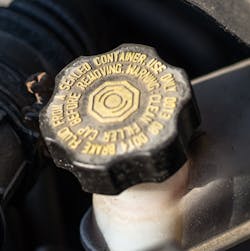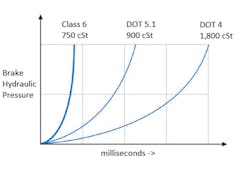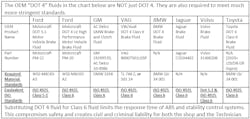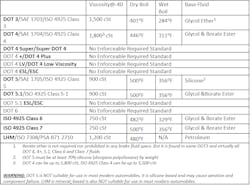Content brought to you by Motor Age. To subscribe, click here.
What you will learn:
• Brake fluid standards are more stringent than ever before
• Response time for brake application and release is a dependent on the brake fluid's characteristics
• Brake fluid materials standards regard more than just DOT rating or ISO Classification
Brake fluid technology has evolved far beyond DOT 3, DOT 4 & DOT 5. Modern antilock brake systems (ABS) and electronic stability control (ESC) are faster and more capable than ever before. Newer electrohydraulic braking (EHB) and autonomous emergency braking (AEB) systems can be even faster yet.
But most DOT 4 brake fluids are not acceptable in this application. Ford service information is far more specific and states that only DOT 4 fluids that meet Ford material standard WSS-M6C65-A2 are acceptable in most modern Ford vehicles. That material standard includes the new ISO 4925 Class 6 ultra-low viscosity requirements.
Time is of the essence
With conventional braking, it takes 300-600 milliseconds to build peak braking pressure after the brake pedal is depressed. Electrohydraulic braking can reduce this to 120-150 milliseconds. Those times are for a simple single brake application. Rapid cycling of brakes in anti-lock or stability control mode creates more complex fluid dynamics. The same type of hydrodynamic forces that allow engine oil to build wedges and waves to reduce engine wear, can delay brake application in modern electrohydraulic brake systems. Controlling and stopping a sliding, spinning, or otherwise out-of-control vehicle is at least partially determined by how quickly those brakes can be applied and released. Faster response times require lower viscosity fluids. Thicker fluid slows the brake application and release.
Brake fluid and engine oil kinematic viscosity is typically measured in centistokes (square centimeters per second). DOT 4 brake fluid viscosity can be up to 1,800 centistokes at -40 degrees C (cSt@-40 degrees C). ISO 4925 Class 4 is very similar but requires a reduced viscosity of 1,500@-40 degrees C. Based on past marketing claims for engine oil, we should expect some ISO 4925 Class 4 fluids to be labeled “low viscosity.” ISO 4925 Class 6 is the thinnest brake fluid at 750 cST@-40 degrees C. When a class 6 fluid is specified, the marketing claim of DOT 4 “low viscosity” should not be assumed to be sufficient.
Key Facts about fluid viscosity
- Kinematic viscosity is typically measured in centistokes (cSt) at 100 degrees C.
- DOT 4 fluids are the thickest brake fluid at 1,800 cSt.
- ISO 4925 Class 6 & Class 7 fluids are the thinnest brake fluids at 750 cSt.
- Thinner fluid is required for faster ABS & ESC response time.
The Department of Transportation (DOT) creates generic brake fluid standards based on Society of Automotive Engineers (SAE) and Federal Motor Vehicle Safety Standard (FMVSS) #116. These basic DOT standards are well known to most North American technicians.
Many of the cars sold in America since 2004 require a brake fluid material standard that includes ISO 4925 Class 6 requirements. These are often labeled “DOT 4-Class 6” or “DOT 4-Low Viscosity”. Unfortunately, many Technicians focus on the “DOT4” requirement instead of the more stringent Class 6 requirement. Any Class 6 or Class 7 fluid also meets DOT 4 requirements. But most DOT 4 fluids do not meet class 6 or class 7 requirements.
EXAMPLE: Ford requires WSS-M6C65-A2 approved “Motorcraft DOT 4 LV” fluid, or similar WSS-M6C65-A2 approved brake fluid. The Ford WSS-M6C65-A2 standard includes the much more stringent ISO 4925 Class 6 (DOT 6) viscosity requirements.
EXAMPLE: VW/Audi Brake Fluid is labeled “DOT 4 Class 6”. DOT 4 is not sufficient for most VW Group vehicles built since 2006. VW required Material Standards “TL 766 Z” and “501 14” both include ISO 4925 Class 6 standards in addition to DOT 4.
Marketing terms such as “super,” “low viscosity (LV),” “electronic stability control (ESC),” “electronic stability program (ESP),” and “plus, (+)” are not well defined or enforceable. Always refer to OEM material standards and their associated DOT standards and ISO 4925 standards. DOT has not yet evaluated or approved any DOT 6. So, any claims of DOT 6 or DOT 7 approval are not credible. Failure to use Class 6 (DOT 6), Class 7 (DOT 7) or DOT 5.1 brake fluids, as required by many vehicle manufacturers, will potentially compromise braking performance.
Braking requires tire traction
Maximum braking performance is achieved by maintaining maximum tire traction. On typical road surfaces, maximum traction is usually achieved as the tire is slipping between 5 and 20 percent, depending on the road surface. ABS repeatedly applies and releases brakes when attempting to maintain this maximum traction. Brake fluid viscosity ultimately determines how quickly the brakes can be applied and released. Faster cycling capability can improve the performance of both braking and stability control.
If you ignore the Material Standard and focus on the “DOT 4” part of “DOT 4-Class 6”, you are making a big mistake. DOT 4 will appear to work normally, and no trouble codes will be set. You probably won’t notice any difference until you need that ABS or ESC system to help avoid a terrible accident on a cold, ice-covered road. That’s when the system will fail! Low temperatures are when the fluid will be the thickest, and slowest!
Think of the liability that will fall on your shop when it is discovered that the fluid you installed is incorrect and caused a fatal accident! In one court case (Shank vs Charger), a motorist experienced problems with their braking system approximately 6 months after a quick lube shop serviced the vehicle. It was shown that a small amount of the wrong fluid had been added by the quick lube shop. There was no collision and no injuries. The only damage was to the vehicle’s braking system. The court awarded $2,500 in damages and an additional $2,468 in attorney fees.
Manufacturers' standards are chosen for a reason
Most manufacturers have their own proprietary “material standards.” Some material standards duplicate DOT or ISO standards. In many cases, they are so close that the generic DOT or ISO standard they can be substituted for the proprietary standard. But many material standards are far more stringent than any current DOT standard. Technicians must focus on the manufacturer's material standard, not the generic DOT Standard.
As the attached chart (Table #2) shows, some manufacturers (Volvo, Jaguar, etc.) use ISO and/or DOT standards instead of proprietary material standards. Volvo requires DOT 4, DOT 5.1 and ISO 4925 Class 6 approval for their newest cars. That does not mean you can choose which spec you meet. It means you must use a fluid that meets all three specifications! The chart also shows that DOT 4 is not sufficient for most modern Ford and GM vehicles. Ford WSS-M6C65-A2 and GMW 3356 material standards both include ISO 4925 Class 6 requirements.
Fluids, in general (especially brake fluids), have become complex enough that our industry may require more training in fluid dynamics and critical reading skills. Far too many technicians fail to read service information comprehensively. Some lack the critical reading skills to accurately interpret the more complicated service information for some new vehicles. We must have the ability (and patience) to read carefully, interpret carefully, and research any technology we don’t yet fully understand.
All the different flavors of brake fluid
DOT 3 (Similar to ISO 4925 Class 3):
DOT 3 is the lowest boiling point and among the highest viscosity of all currently common brake fluids. It should not be substituted for other brake fluids.
DOT 4 Brake Fluid (Similar to ISO 4925 Class 4):
DOT 4 has the highest maximum allowable viscosity of any brake fluid and therefore has the slowest response time. Even DOT 3 and ISO 4924 Class 4 have slightly lower maximum allowable viscosity than DOT 4. But most DOT 4 products are formulated to also meet DOT 3 viscosity requirements. DOT 4 is glycol based and is often formulated with slightly lower viscosity so that it can be backwards compatible with DOT 3.
DOT 5.1 Brake Fluid (similar to ISO 4925 Class 5-1):
The dual specifications DOT 5.1 and ISO 4925 Class 5-1 have the HIGHEST boiling point. They also have significantly lower maximum allowable viscosity than DOT 3 or 4. DOT 5.1 is glycol based and backwards compatible to DOT 3 & DOT 4. WARNING: DOT 5 shares the same boiling point as DOT 5.1 and Class 5-1 but is silicone based and cannot be mixed with any other fluid or substituted for any other fluid.
Class 6 Brake Fluid (AKA DOT 6):
ISO 4925 Class 6 (DOT 6) brake fluid has the LOWEST viscosity and is required in many modern automobiles. Class 6 is glycol-based and backwards compatible to DOT 3, DOT 4 & DOT 5.1.
Class 7 Brake Fluid:
ISO 4925 Class 7 (DOT 7) brake fluid has the LOWEST viscosity and the HIGHEST boiling Point. Class 7 matches the boiling point of DOT 5.1 and the low viscosity of Class 6. Class 7 is glycol based and backwards compatible to DOT 3, DOT 4, DOT 5.1 & Class 6.
Obsolete and Non-Compatible Fluids:
DOT 1 &2, ISO 4925 Class 1&2 are obsolete fluids. DOT 5 (usually red/purple) is silicone based. LHM (usually green) is mineral oil based. None of these should ever be mixed with or substituted for any other fluid.
WARNING: When an OEM mentions multiple standards, make certain you meet ALL REQUIRED standards. Modern Technicians MUST have reasonable “Technical Reading Skills”. The Ford WSS-M6C65-A2 material standard is an important example. Far too many Technicians read the Ford brake fluid requirements in Alldata, Mitchell or Ford service information and misinterpret the statement. The Ford Material standard is the requirement, not DOT 4!
To 'brake' it down further (pardon the pun), there are a variety of brake fluid specifications that are designed to meet the needs of the systems they are being used in. Paying mind to not only the DOT rating and/or ISO Classification) but also to what each manufacturer requires for their materials standards will ensure safety and proper brake hydraulic system performance.
About the Author
Kevin McCartney
Kevin McCartney serves the automotive service/repair industry as a trainer, consultant, and writer. Connect with him on LinkedIn.





